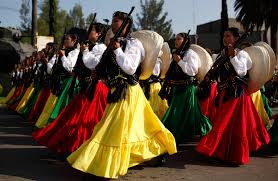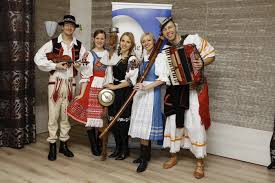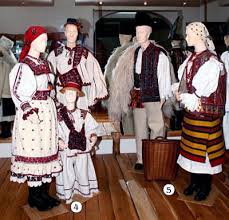source(google.com.pk)
Traditional Dresses For Girls Biography
Croatia:
The Croatian costume reveals in some cases a middle point between their ethnic Slavic customs and the Hungarian & German authority that ruled Croatia for nearly 1,000 years.
Spain (including Galician Celts):
The famous Spanish costumes are unique to the Iberian peninsula, expressing the Portuguese' and Spaniards' distinct heritage and sovereignty. It must be acknowledged that each sub-national identity in Spain has its own national costume and visual heritage. Andalusia, the Catalans, the Basques, and the "Celts" of Galicia have their own costumes. Galicia in the northwest, whose inhabitants consider themselves descendents of the Celtoiberians and not of the mainland Spaniards, have a unique costume shocking to many because it is almost identical to that of the Ku Klux Klan.
Basque Country:
The Basques of northern Spain attempt to use their bizarrely unique national dress as an outlet to express their independent history, customs, and tradition as the only surviving Spanish community free of Latin historic influence.
Germany, Netherlands, Austria, Switzerland:
Germany's costumes are slightly diverse. The major costume for men in Germanic countries (Norway, Denmark, Austria, Germany, etc.) is a form of the Lederhosen. For women, the dress varies broadly. In Brandenburg (the state housing Berlin), traditional dress may bear a slight Slavic influence because of the presence of Slavs there today and before the German empire conquered the region from the broken Polish state under Heinrich the Lion. In Switzerland, where the Germans are the majority population, the German-Austrian costume is generally worn. The French and Italian minorities wear their respective dresses. The Netherlands has famous distinctions of their own, derived largely from German tradition because of a shared heritage and history. Belgium's Dutch (the Flemings), having broken from the Dutch only in the 19th century, are largely indistinguishable in terms of national dress.
Denmark, Sweden, Norway, Iceland, Finland (includes Saami tribes)
All of Scandinavia wears a common or similar dress largely influenced by Denmark and Germany because of centuries of shared rule by the Danes (greatly influenced by their German relatives to the south). Finland's dress is related to the Swedish a common heritage springing from nearly 600 years of Swedish rule.
The Saami tribes of northern Scandinavia have a very unique dress of their own because of their isolation from Germanic culture to the south. Their ethnicity is the same.
Greece:
The Greek costume is highly unique, with no other country similar to it. Greeks are very proud of their military tradition, and treat these costume-donning regulars on the public squares of Athens with great respect.
This article shows a variety of cultural dress and traditional costumes from distinct European cultures. Note that there are too many varieties to possibly delineate, so this article emphasizes the cultural and ethnic traits of these peoples overall. Please wait for the images to load; there are hundreds. Note that many of these costumes are obsolete and seldom used, and that an image search online often seems to give conflicting and duplicated results. I have received a few complaints that some of the images shown are not fully reflective or are somewhat inaccurate. I have done my best to correct this. Feel free to email me if you have any suggestions or improvements.
Croatia:
The Croatian costume reveals in some cases a middle point between their ethnic Slavic customs and the Hungarian & German authority that ruled Croatia for nearly 1,000 years.
Spain (including Galician Celts):
The famous Spanish costumes are unique to the Iberian peninsula, expressing the Portuguese' and Spaniards' distinct heritage and sovereignty. It must be acknowledged that each sub-national identity in Spain has its own national costume and visual heritage. Andalusia, the Catalans, the Basques, and the "Celts" of Galicia have their own costumes. Galicia in the northwest, whose inhabitants consider themselves descendents of the Celtoiberians and not of the mainland Spaniards, have a unique costume shocking to many because it is almost identical to that of the Ku Klux Klan.
The Castilian standard
Portugal:
Portuguese costume reveals a cultural and ethnic link to their Spanish relatives, with slight divergences to reflect Portugal's longer and distinct history. It is, interestingly, similar in many ways to Basque dress.
The first picture in the Portugal's section (the woman dressed in a red costume) is typical in Northern Portugal, specially in the Minho region, but that clothing in Portuguese folklore actually goes along with what we call the "A Noiva" (which literally means "The Bride" ). "As Noivas" are women dressed in black with extremely beautiful pure gold necklace and garments. You can actually see a woman dressed in black in that picture, behind the lady in red, but you don't see the front part. I am sending you some pictures of these costumes (along with the male partner). They are associated to the city of Viana do Castelo and are mainly related to religious traditions related to the sea, but you can find them in many fishing towns in Northwestern Portugal. These garments are actually said to have been much more luxurious in the past, but the old fascist regime opressed them for over 50 years.
The other costume is what we call "Pauliteiros of Miranda do Douro" and are typical in Northeastern Portugal. They basically are men in skirts who dance at the sound of bagpipes (traditional Portuguese music) with sticks. These costumes are unique in Portuguese folklore, you won't find them anywhere in Spain, not even Galicia. They are typical in the city of Miranda do Douro, but you can find them now all over the country where the Portuguese bagpipe is played (Portuguese people play 2 types of bagpipes - the Galician one and the "transmontana", commonly known as the "Portuguese bagpipe" with a much stronger sound, perfect for outdoor performances).
Unlike the Scotts, Portuguese bagpipers are not allowed to use skirts, only young male dancers should use them. These bagpipers use a type of costume that is, in my opinion, very similar to other folk dances all over the country.
Basque Country:
The Basques of northern Spain attempt to use their bizarrely unique national dress as an outlet to express their independent history, customs, and tradition as the only surviving Spanish community free of Latin historic influence.
Germany, Netherlands, Austria, Switzerland:
Germany's costumes are slightly diverse. The major costume for men in Germanic countries (Norway, Denmark, Austria, Germany, etc.) is a form of the Lederhosen. For women, the dress varies broadly. In Brandenburg (the state housing Berlin), traditional dress may bear a slight Slavic influence because of the presence of Slavs there today and before the German empire conquered the region from the broken Polish state under Heinrich the Lion. In Switzerland, where the Germans are the majority population, the German-Austrian costume is generally worn. The French and Italian minorities wear their respective dresses. The Netherlands has famous distinctions of their own, derived largely from German tradition because of a shared heritage and history. Belgium's Dutch (the Flemings), having broken from the Dutch only in the 19th century, are largely indistinguishable in terms of national dress.
Denmark, Sweden, Norway, Iceland, Finland (includes Saami tribes)
All of Scandinavia wears a common or similar dress largely influenced by Denmark and Germany because of centuries of shared rule by the Danes (greatly influenced by their German relatives to the south). Finland's dress is related to the Swedish a common heritage springing from nearly 600 years of Swedish rule.
The Saami tribes of northern Scandinavia have a very unique dress of their own because of their isolation from Germanic culture to the south. Their ethnicity is the same.
Greece:
The Greek costume is highly unique, with no other country similar to it. Greeks are very proud of their military tradition, and treat these costume-donning regulars on the public squares of Athens with great respect.
Italy:
Italy's costumes are diverse, reflecting Italy's history as a nation seldom unified throughout its history, though its regions retain the same ethnicity and culture.
Traditional Dresses For Girls Biography
Croatia:
The Croatian costume reveals in some cases a middle point between their ethnic Slavic customs and the Hungarian & German authority that ruled Croatia for nearly 1,000 years.
Spain (including Galician Celts):
The famous Spanish costumes are unique to the Iberian peninsula, expressing the Portuguese' and Spaniards' distinct heritage and sovereignty. It must be acknowledged that each sub-national identity in Spain has its own national costume and visual heritage. Andalusia, the Catalans, the Basques, and the "Celts" of Galicia have their own costumes. Galicia in the northwest, whose inhabitants consider themselves descendents of the Celtoiberians and not of the mainland Spaniards, have a unique costume shocking to many because it is almost identical to that of the Ku Klux Klan.
Basque Country:
The Basques of northern Spain attempt to use their bizarrely unique national dress as an outlet to express their independent history, customs, and tradition as the only surviving Spanish community free of Latin historic influence.
Germany, Netherlands, Austria, Switzerland:
Germany's costumes are slightly diverse. The major costume for men in Germanic countries (Norway, Denmark, Austria, Germany, etc.) is a form of the Lederhosen. For women, the dress varies broadly. In Brandenburg (the state housing Berlin), traditional dress may bear a slight Slavic influence because of the presence of Slavs there today and before the German empire conquered the region from the broken Polish state under Heinrich the Lion. In Switzerland, where the Germans are the majority population, the German-Austrian costume is generally worn. The French and Italian minorities wear their respective dresses. The Netherlands has famous distinctions of their own, derived largely from German tradition because of a shared heritage and history. Belgium's Dutch (the Flemings), having broken from the Dutch only in the 19th century, are largely indistinguishable in terms of national dress.
Denmark, Sweden, Norway, Iceland, Finland (includes Saami tribes)
All of Scandinavia wears a common or similar dress largely influenced by Denmark and Germany because of centuries of shared rule by the Danes (greatly influenced by their German relatives to the south). Finland's dress is related to the Swedish a common heritage springing from nearly 600 years of Swedish rule.
The Saami tribes of northern Scandinavia have a very unique dress of their own because of their isolation from Germanic culture to the south. Their ethnicity is the same.
Greece:
The Greek costume is highly unique, with no other country similar to it. Greeks are very proud of their military tradition, and treat these costume-donning regulars on the public squares of Athens with great respect.
This article shows a variety of cultural dress and traditional costumes from distinct European cultures. Note that there are too many varieties to possibly delineate, so this article emphasizes the cultural and ethnic traits of these peoples overall. Please wait for the images to load; there are hundreds. Note that many of these costumes are obsolete and seldom used, and that an image search online often seems to give conflicting and duplicated results. I have received a few complaints that some of the images shown are not fully reflective or are somewhat inaccurate. I have done my best to correct this. Feel free to email me if you have any suggestions or improvements.
Croatia:
The Croatian costume reveals in some cases a middle point between their ethnic Slavic customs and the Hungarian & German authority that ruled Croatia for nearly 1,000 years.
Spain (including Galician Celts):
The famous Spanish costumes are unique to the Iberian peninsula, expressing the Portuguese' and Spaniards' distinct heritage and sovereignty. It must be acknowledged that each sub-national identity in Spain has its own national costume and visual heritage. Andalusia, the Catalans, the Basques, and the "Celts" of Galicia have their own costumes. Galicia in the northwest, whose inhabitants consider themselves descendents of the Celtoiberians and not of the mainland Spaniards, have a unique costume shocking to many because it is almost identical to that of the Ku Klux Klan.
The Castilian standard
Portugal:
Portuguese costume reveals a cultural and ethnic link to their Spanish relatives, with slight divergences to reflect Portugal's longer and distinct history. It is, interestingly, similar in many ways to Basque dress.
The first picture in the Portugal's section (the woman dressed in a red costume) is typical in Northern Portugal, specially in the Minho region, but that clothing in Portuguese folklore actually goes along with what we call the "A Noiva" (which literally means "The Bride" ). "As Noivas" are women dressed in black with extremely beautiful pure gold necklace and garments. You can actually see a woman dressed in black in that picture, behind the lady in red, but you don't see the front part. I am sending you some pictures of these costumes (along with the male partner). They are associated to the city of Viana do Castelo and are mainly related to religious traditions related to the sea, but you can find them in many fishing towns in Northwestern Portugal. These garments are actually said to have been much more luxurious in the past, but the old fascist regime opressed them for over 50 years.
The other costume is what we call "Pauliteiros of Miranda do Douro" and are typical in Northeastern Portugal. They basically are men in skirts who dance at the sound of bagpipes (traditional Portuguese music) with sticks. These costumes are unique in Portuguese folklore, you won't find them anywhere in Spain, not even Galicia. They are typical in the city of Miranda do Douro, but you can find them now all over the country where the Portuguese bagpipe is played (Portuguese people play 2 types of bagpipes - the Galician one and the "transmontana", commonly known as the "Portuguese bagpipe" with a much stronger sound, perfect for outdoor performances).
Unlike the Scotts, Portuguese bagpipers are not allowed to use skirts, only young male dancers should use them. These bagpipers use a type of costume that is, in my opinion, very similar to other folk dances all over the country.
Basque Country:
The Basques of northern Spain attempt to use their bizarrely unique national dress as an outlet to express their independent history, customs, and tradition as the only surviving Spanish community free of Latin historic influence.
Germany, Netherlands, Austria, Switzerland:
Germany's costumes are slightly diverse. The major costume for men in Germanic countries (Norway, Denmark, Austria, Germany, etc.) is a form of the Lederhosen. For women, the dress varies broadly. In Brandenburg (the state housing Berlin), traditional dress may bear a slight Slavic influence because of the presence of Slavs there today and before the German empire conquered the region from the broken Polish state under Heinrich the Lion. In Switzerland, where the Germans are the majority population, the German-Austrian costume is generally worn. The French and Italian minorities wear their respective dresses. The Netherlands has famous distinctions of their own, derived largely from German tradition because of a shared heritage and history. Belgium's Dutch (the Flemings), having broken from the Dutch only in the 19th century, are largely indistinguishable in terms of national dress.
Denmark, Sweden, Norway, Iceland, Finland (includes Saami tribes)
All of Scandinavia wears a common or similar dress largely influenced by Denmark and Germany because of centuries of shared rule by the Danes (greatly influenced by their German relatives to the south). Finland's dress is related to the Swedish a common heritage springing from nearly 600 years of Swedish rule.
The Saami tribes of northern Scandinavia have a very unique dress of their own because of their isolation from Germanic culture to the south. Their ethnicity is the same.
Greece:
The Greek costume is highly unique, with no other country similar to it. Greeks are very proud of their military tradition, and treat these costume-donning regulars on the public squares of Athens with great respect.
Italy:
Italy's costumes are diverse, reflecting Italy's history as a nation seldom unified throughout its history, though its regions retain the same ethnicity and culture.
Traditional Dresses For Girls
 Traditional Dresses For Girls
Traditional Dresses For Girls









Traditional Dresses For Girls
Traditional Dresses For Girls
Traditional Dresses For Girls
Traditional Dresses For Girls
Traditional Dresses For Girls
Traditional Dresses For Girls
Traditional Dresses For Girls
Traditional Dresses For Girls
Traditional Dresses For Girls
No comments:
Post a Comment